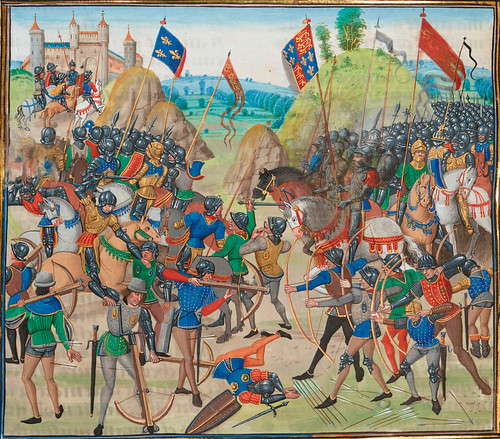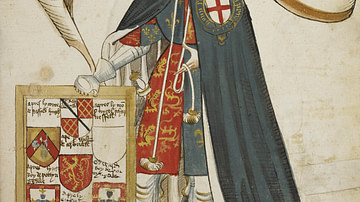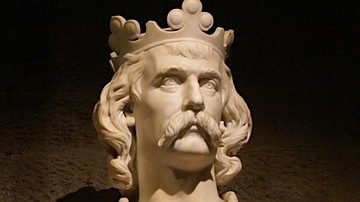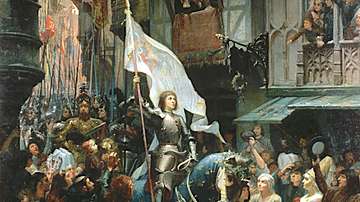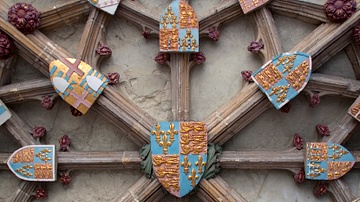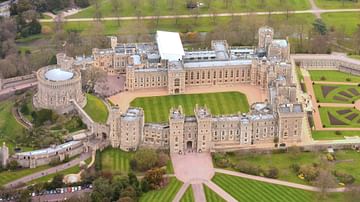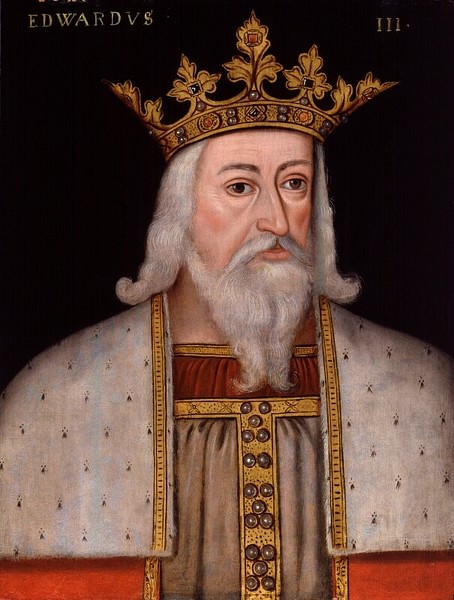
Edward III of England reigned as king from 1327 to 1377 CE. Succeeding his father Edward II of England (r. 1307-1327 CE) following his enforced abdication and then murder, Edward III would take revenge on his father's enemies, who included the young king's own mother Isabella of France, and go on to reign for 50 years. The king reunified the troublesome English barons, extended Windsor Castle, established a new era of medieval chivalry, and embarked on the Hundred Years' War with France (1337-1453 CE) to force his claim to the French throne. English territory in France was greatly expanded, but the war took a heavy financial toll on the kingdom, a situation only worsened by the arrival of the Black Death in 1348 CE. The king suffered two dreadful blows towards the end of his reign when his gains in France were lost and his son Edward of Woodstock (1330-1376 CE), aka Edward the Black Prince, died prematurely. Consequently, when Edward III died of a stroke in June 1377 CE, he was succeeded by his grandson, Richard II of England (r. 1377-1399 CE).
Succession
Edward III was born on 13 November 1312 CE at Windsor Castle, the son of King Edward II of England and Isabella of France (b. c. 1289 CE), the daughter of Philip IV of France (r. 1285-1314 CE). Edward's parents had married largely for diplomatic reasons and to produce an heir. In this latter respect, the marriage was a success and four children were produced. In most other respects the marriage was a disaster. Edward II is strongly suspected of having homosexual relations with at least two of his courtiers (although historians do not agree on the exact relationships), and Isabella thus spent most of her time in France with the young Edward by her side. There she openly took a lover, the English baron and anti-royalist Roger Mortimer (1287-1330 CE). The couple plotted to attack England and depose Edward II. Having lost the support of his barons through his patronage of dubious characters and military incompetence regarding Scotland, the English king could do nothing to stop Isabella and Mortimer from fulfilling their plans in October 1326 CE. Edward was obliged to formally abdicate on 24 January 1327 CE, and he was then imprisoned and murdered in Berkeley Castle in Gloucestershire on 21 September 1327 CE.
Regency
With his father's demise, the young Prince Edward, aged just 14, was declared king with Isabella and Mortimer acting as his regents. Edward III thus became the final part of the trio that completed the 'Edwardian' period of medieval England (1272-1377 CE). The coronation took place on 1 February 1327 CE, as usual, at Westminster Abbey. There followed a purge of Edward II's entourage, but the boy-king proved to be not so easily manipulated. Soon enough, Edward gained revenge for his father's murder in October 1330 CE by surprising his regents in their chamber at Nottingham Castle by using a secret passageway. Roger Mortimer was imprisoned in the Tower of London and later executed as a traitor on 29 November 1330 CE while his mother was banished to a life of confinement at Castle Rising in Norfolk. Neither Mortimer or Isabella were missed, the pair having spent their time as regents largely lining their own pockets and those of their associates with the kingdom's treasures and prized estates. Edward III now presented an opportunity for a fresh start and some much-needed stability.
On 24 January 1328 CE Edward married Philippa of Hainault (c. 1314-1369 CE) with whom he had 13 children in all. His most famous son was his eldest, Edward of Woodstock, better known since the 16th century CE as the Black Prince (probably after the unusual black armour and shield he bore). Edward would become, as was now the tradition, the Prince of Wales in 1343 CE and one of the greatest of all medieval knights, thanks to his exploits in France. Both Edwards, father and son, would bring about a new golden era for England.
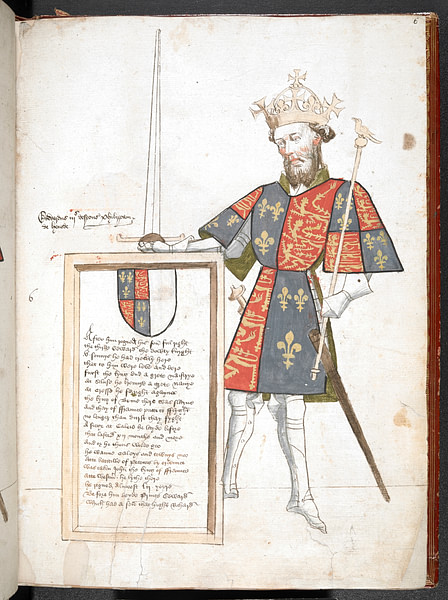
Scotland
Scotland's independence had been secured in the 1328 CE Treaty of Northampton, but Edward had not given up on the dream of his grandfather, Edward I of England (r. 1272-1307 CE), to conquer the country. When the Scottish king Robert the Bruce died in 1329 CE after a 23-year reign, his successor was David II (r. 1329-1371 CE), then only five years old. The Balliols, long-standing rivals to the Bruces, saw an opportunity to re-stake their claim to the throne. Edward, too, took the chance to stir things up and so supported Edward Balliol (c. 1283-1367 CE) in the dispute despite his sister having been betrothed to David when Mortimer and Isabella had been regents. The English king's support proved vital. David was deposed in 1332 CE, and Balliol was made king but he was himself then deposed despite Edward's victory at the Battle of Halidon Hill on 19 July 1333 CE where the English king used a combination of archers and topography to great effect. There was another round of musical thrones but by the end of 1336 CE, David II was back and the border was eventually re-established along traditional lines while Edward turned his attention to the richer prize of France.
France: the Hundred Years' War
Edward III held lands in France and he could even make a strong claim to the French crown via his mother Isabella. The current French king was Philip VI of France (r. 1328-1350 CE) who had succeeded his cousin Charles IV of France (r. 1322-1328 CE) even if, when Charles had died, it was Edward who was his closest male relative, being Charles' nephew. The English king had not pressed his claim at the time, and the French nobility, discounting the legitimacy of inheritance through the female line, had naturally preferred a Frenchman as their ruler. However, by the mid-1330s CE Edward changed his strategy. By making a claim for the throne Edward could avoid a rebuke from the Pope for causing an unnecessary war and the rich lands available in France could be used as a lure for baronial support. The two equally ambitious kings thus, in 1337 CE, sparked off what would become known as the Hundred Years' War between France and England (a 19th-century CE label for a conflict which rumbled on intermittently for well over a century, in fact, finally ending in 1453 CE). To show his intent, and in a typical piece of visual propaganda and pageantry, Edward henceforth quartered his coat of arms - the three lions of the Plantagenets - to now include the golden fleur-de-lis of France, which remained a part of the royal arms until 1801 CE.
In June 1340 CE a French fleet, probably intended to serve as a means to invade England, was sunk by an English fleet at Sluys in the Scheldt estuary (Low Countries). 190 French ships of 200 were destroyed or captured. On land, however, at least at first, Philip was the more cautious of the two adversaries and avoided any all-out battles which led to Edward even offering a personal duel to settle the matter. The English king's romantic view of battle would manifest itself in other ways as the period saw a great revival (or simply invention) of medieval chivalry and the glorification of war.
1345 CE saw a move forward when the Earl of Derby recaptured Gascony for the English Crown. Edward followed this up in July 1346 CE by invading Normandy, pillaging the towns and cities there - including Caen - and forcing Philip to show his hand and meet the army at Crécy on 26 August 1346 CE. Edward's army overcame their numerical disadvantage (around 12,000 v. 25,000) by taking a defensive position on a rise overlooking the River Maie. The French troops got into a muddle when a charge was ordered and then retracted, and the Welsh and English archers proved as devastating as ever. Edward's army also benefitted from its battle experience and discipline gained fighting in Scotland and Wales and from the king's emphasis on light mobile troops, not to mention the first use of cannons on French soil. Edward won the battle with around 300 casualties compared to the 14,000 fallen French, the massacre a result of the French having raised their banner to give no quarter. The flower of France's nobility and that of its allies was eliminated, including the king of Bohemia, the Count of Blois, and the Count of Flanders. The English king went on to attack and take, after a massive one-year siege, the vital port of Calais in July-August 1347 CE. Edward III was at the very peak of his success.
Philip was far from beaten, though, and cleverly called on his Scottish allies to invade northern England and force Edward to withdraw from France. David II obliged and invaded England in October 1346 CE. Durham was the target, but an English army led by, amongst others, the impressively named William la Zouche, Archbishop of York, defeated the Scots at the Battle of Neville's Cross outside the city (17 October 1346 CE), and David was captured.

The Black Death plague pandemic arrived in Europe from 1347 CE and England the following year. Besides killing countless people of all classes - perhaps 30-50% of the population in affected areas with even the king's favourite daughter Joan succumbing - it brought the economy crashing down as farmers, labourers, and craftsmen succumbed to the disease. The disaster interrupted the Hundred Years' War, but the conflict was resumed following the succession of Philip's son John the Good, aka John II of France (r. 1350-1364 CE). However, it was not a king but a prince, Edward's namesake son, who became the star of the next act of the war. The Black Prince, who had already fought with distinction at Crécy, won a great victory at Poitiers on 19 September 1356 CE. Again the French outnumbered their opponents (35,000 v. 7,000) and again muddled leadership and an outdated reliance on heavy cavalry annulled their advantage. John II was captured, and the Black Prince won further distinction for his chivalrous treatment of his royal prisoner. Unfortunately for the French locals, the Black Prince showed fewer scruples when systematically pillaging and torching their lands both before and after the battle.
Back in England, Edward was now sitting pretty with two kings in his prisons. David II was the first to be released in 1357 CE as part of the Treaty of Berwick (6 November), where the Scots paid a ransom and a 10-year truce was agreed between the two countries. Edward was then audacious enough to march on Rheims in 1359 CE, fully intending to have himself made king of the French where their monarchs were traditionally crowned. Rheims proved impregnable, though, and a harsh winter so reduced Edward's army he was obliged to start peace talks. In May 1360 CE a treaty was signed between England and France. Under the Treaty of Brétigny, which was, in truth, rather vague on many points, Edward's claim to 25% of France (mostly in the north and south-west) was recognised and, in return, he gave up any ambition for the French crown itself. John II was released after his ignominious four years in captivity but not without his court paying a hefty ransom first. So far, the great war with France had all been remarkably easy.
Unfortunately for Edward III, holding on to his gains in France proved much more difficult than acquiring them. The Black Death still caused havoc as it came and went in waves of destruction, and a new French king proved to be a much more worthy opponent than his predecessors: Charles V of France, aka Charles the Wise (r. 1364-1380 CE). Charles began to grab back in earnest what his predecessors had lost by avoiding open battle and concentrating on harassment and relying on the safety of his castles when required. The English king was also now struggling to pay for his hugely expensive wars. Edward had been obliged to impose repeated taxes on his subjects, actually 27 times during his reign to fund his various campaigns. The king also borrowed heavily from Italian, Flemish, German and English bankers, most of whom got nothing from their investment when the king declared himself bankrupt in the 1340s CE. Charles V's strategy brought dividends as he overran most of Aquitaine in 1372 CE, and by 1375 CE, the only lands left in France belonging to the English Crown were Calais and a slice of Gascony, a meagre return for decades of effort and expense.
Domestic Events
From 1341 CE the English Parliament was beginning to take the form it has today with two separate houses sitting, the lower and the upper house (what would become the House of Commons and House of Lords respectively). The Parliament was able to push for more powers as the king became more desperate for funds, and these included the Houses first approving any new taxes, imposing a pledge of acceptance of the 1215 CE Magna Carta charter of liberties by royal ministers, and prohibiting the king from arbitrarily annulling statutes. Edward was himself concerned with judicial corruption in his kingdom, and he took various measures to reduce it such as forbidding, from 1346 CE, anyone involved in local courts from taking fees or robes from those involved in a case, speeding up prosecutions, and more actively checking abuses of correct weights and measures by traders.
Knights & Chivalry
During the good times of the victories in France, Edward's court became famous for its pageantry, extravagant clothing and chivalry. Medieval literature boomed, too, with the celebrated poet Geoffrey Chaucer, (c. 1343-1400 CE) a member of the king's inner circle from 1367 CE onwards. Edward, a keen student of history, seemed intent on creating a new Camelot, the court of the legendary King Arthur. In 1344 CE the king held a great medieval tournament involving 200 knights where jousters dressed up as characters from the Arthurian legends. Around 1348 CE Edward went one step further and created the Order of the Garter. This order, England's oldest and still most prestigious, was created with only 24 chosen knights plus the king and his son, the Black Prince. All of its first members had fought at the Battle of Crécy; these were men of valour not just rank. The symbol of this order is a garter (then worn on the upper arm or upper leg over armour) and its motto is Honi soit, qui mal y pense or 'Evil be on him who thinks it', most likely a reference to anyone who doubted the king's right, as he saw it, to rule France. It is no coincidence that the garter also had the royal colours of France - gold and blue. All of this chivalrous pomp served to glorify warfare, the king's main preoccupation during his reign, and ensure the loyalty of his nobles and instil in them a desire for daring-do.
Edward even built Saint George's Chapel at Windsor Castle to be the spiritual home of his order, which still survives today and which holds each June a magnificent procession of medieval pageantry. Indeed, Edward renovated the whole of Windsor Castle, making it the finest royal residence in Europe. The whole project cost the king a massive 50,000 pounds (over $70 million today), more than any medieval English monarch ever spent on a single building.
Death & Successor
By the end of his reign, Edward was becoming increasingly unpopular and perhaps his mind was suffering from his age. There were no more victories in France to cheer, the state coffers and just about everyone else's were empty, and the king's scheming mistress, Alice Perrers - Queen Philippa had died of illness in 1369 CE - proved unpopular at court as she siphoned off riches for herself. In April 1376 CE a Parliament was convened, known as the 'Good Parliament', which sought to reduce the corruption in the royal household and which also banished Perrers. It seemed, though, the king was losing his grip on power and life.
Edward suffered a stroke in 1376 CE and, never really recovering, he died on 21 June 1377 CE at Sheen Palace in Surrey. He was 64. Buried in Westminster Abbey, his tomb carries the following inscription:
The glory of the English, the flower of kings past, a pattern for kings to come.
Unfortunately, Edward, the able and well-respected Black Prince (in England anyway) had also died, probably of dysentery, the year before and so a generation was skipped. The new king was the Black Prince's son, who became Richard II of England as the other leading candidate, John of Gaunt (1340-1399 CE), another son of Edward III and Duke of Lancaster, was ruled out because of his support for those who the Good Parliament had found guilty of corruption and misrule. King Richard was just 10 years of age but he had already been recognised by Parliament as the official heir. Richard II turned out to be rather too confident in his divine right to rule and, ignoring his barons, Parliament and commoners alike, he got his comeuppance in 1399 CE when he was imprisoned and starved to death in Pontefract Castle in Yorkshire.
